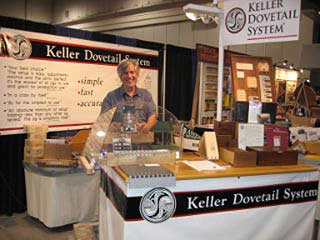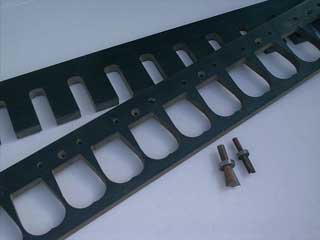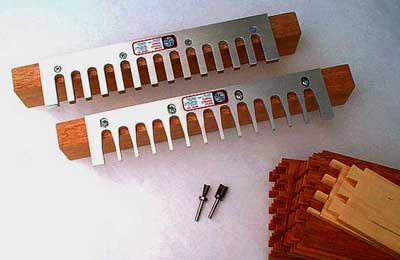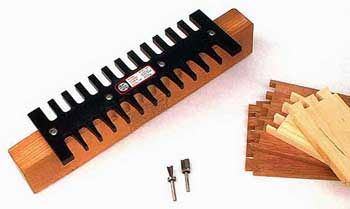
After 33 years of making dovetail jigs, David Keller continues to prove that there’s more than one way to stay viable in the woodworking product industry. Unlike some other companies, which continue to expand their product lines with a perpetual stream of new gadgets, Keller & Company still focuses on essentially the same dovetailing jig that got the organization on its feet in the mid 1970s. It seems that innovation isn’t the only force that drives success. Sometimes, if you solve one problem and solve it well, new customers will seek you out decade after decade.
“I tell prospective customers my Keller Dovetail System is usable, repeatable and honest. It won’t do every joint possible, but what it does do it does extremely well and enjoyably…For many woodworkers, this has been the critical difference in whether they use dovetail joinery in their woodworking, or if their complicated jigs sit on a shelf or go to the flea market and to eBay®,” David says.
In hindsight, however, arriving at a better solution for dovetailing came almost by accident. Through a rather circuitous path of career attempts, which included doctoral studies in social psychology, a short-lived stint as a musician and finally furniture building, David ended up apprenticing in the shop of Arthur Espenet Carpenter — one of five master woodworkers who helped to shape the contemporary American craft furniture movement. The year was 1971.
“I fell in love with Art’s furniture. As a new apprentice in Espenet’s shop, I started out sanding for no pay. That was the entire extent to which Art was willing to let me use machines, and I got pretty damn good at sanding…When Art eventually hired me on, I swept the shop for $2 an hour,” David recalls. Apprenticeships were common in Art’s shop, and despite those humble beginnings, it was a fertile and productive time to be a woodworker. The American public was beginning to embrace the importance of handmade craft furniture, and there was a booming market for really good work.
At the time, through dovetails were cut exclusively by hand, and Art Carpenter’s furniture was full of them. There were no through dovetail jigs to tackle the task with a router. Router dovetailing was limited to half-blind joints. David recalls that those jigs were “obscenely slow to set up, always involving a frustrating trial-and-error process and lots of wasted wood.” And, they required using a guide collar on the router, which was prone to being off-center in the base, leading to misaligned joints.
But, Art had the genesis for a revolution in machine dovetailing. He had developed a crude Plexiglas jig screwed to a 2 x 6 that enabled him to cut through dovetails with a 14° dovetail bit. According to David, Art was the first to figure out the correct geometry. That early prototype worked fine until a new commission required him to rout dovetails on 1 1/4-in.-thick stock. It exceeded the capacity of his jig, and Art needed a new solution.
David took the challenge to heart and drafted a set of plans to have Art’s prototype jig machined from phenolic at a local machine shop. “I took the concept and brought it up to machine tool standards instead of woodworking tool standards,” David recalls.
And so ushered in the run of Keller Dovetail Jigs — only 16 that first time around. Soon, thanks to the feedback from friends at the Balinas Craftsman Guild and other early customers, David switched to 1/2-in.-thick aluminum tooling plate, milled by a CNC machine. The second production run of aluminum jigs were sturdy enough to take the daily abuse of production work. He obtained his first patent in 1977, and three more patents followed the first.
Innovation didn’t stop with the jig, however. Art and David also revolutionized the bit system that would function with the new jig.
“Instead of a guide bushing on the router, which we thought was inherently inaccurate, we decided to put a ball bearing on the bit’s shank. It was a novel concept, and we became the first manufacturer of dovetail pattern routing bits as well,” David says. The addition of a bearing enabled both the required dovetail and straight bits to remain concentric to the bit axis. That closed the gap on joint accuracy and prevented any wear on the dovetail templates.
After about three years, David left Art’s shop to venture out on his own and develop Keller & Company. It was a side business that he maintained while working as a full-time high-end trim carpenter, timber framer and furniture builder.
“It wasn’t uncommon for me to wake from a dead sleep at 5:00 a.m. to answer a customer call from someone on the East Coast asking about my dovetail jigs. My wife could never understand how I could do that,” David says. Nevertheless, the word was spreading.
Then, the early 1980s ushered in consumer woodworking trade shows, and along with them a whole new market of hobbyist woodworkers, eager for a better way to cut dovetails. Keller & Company was there to meet the need, and steady growth came along with it.
Since that time, the company’s product line has remained limited and true to its roots with just a few additions. Although early Keller Dovetail Jigs were only offered in 36-in. lengths, David has since added 24- and 16-in. sizes to handle medium to smaller sized boxes and drawers. In the mid 1990s, Keller & Company also introduced the Journeyman Jig series, which incorporate both pin and tail templates into one back-to-back design. Journeyman Jigs retain the same template patterns and precision standards as the Pro Series jigs, but they’re milled from phenolic instead of aluminum. And, they cost less — a move made to satisfy hobbyist budgets.
Over the years, and in spite of the successes, David admits to having had a period when he grew weary of “selling” woodworkers on the virtues of his jigs. But, trade shows renewed his source of energy, then and now. “Woodworkers are a pretty congenial lot and very sincere about what they’re doing. When they come up and tell me that their Keller Dovetail Jig is the best tool in their shop or the only dovetail jig they’ll ever use after trying some others, I’m affirmed about why I’m still in this business and connected to the craft,” he says.
And what of the future? Will there be another breakthrough Keller Dovetail Jig to come?
David says the company will continue to do what it does best, making through dovetail jigs here in America. Well, that is until David can see his “Holy Grail” innovation happen: “When I can develop a half-blind dovetail jig that requires no adjustments or test cuts, I’ll make it and put my name on it. Anything less is just one more frustrating jig on the market. If it doesn’t work better than most of these do, it’s not worth it.”








